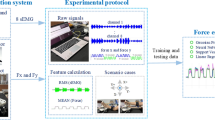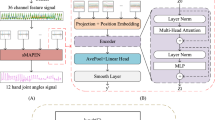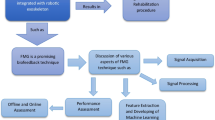Abstract
Estimating interaction force is of great significance in the field of human-robot interaction (HRI) thanks to its guarantee of interaction safety. To this end, this paper proposes a novel estimation method by leveraging broad learning system (BLS) and human surface electromyography (sEMG) signals. Since the previous sEMG may also contain valuable information of human muscle force, it would cause the estimation to be incomplete and abate the estimation accuracy in the case of neglecting the previous sEMG. To remedy this thorn, a new linear membership function is first developed to calculate contributions of sEMG at different sampling times in the proposed method. Subsequently, the contribution values calculated by the membership function are integrated with features of sEMG to be considered as the input layer of BLS. For extensive studies, five different features extracted from sEMG signals and their combination are explored to estimate the interaction force by the proposed method. Lastly, the performance of the proposed method is compared with those of three well-known methods through experimental test regarding the drawing task. The experimental results confirm that combining the time domain (TD) with frequency domain (FD) features of sEMG can enhance the estimation quality. Moreover, the proposed method outperforms its contenders with respect to estimation accuracy.
Graphical abstract



















Similar content being viewed by others
References
Ficuciello F, Villani L, Siciliano B (2015) Variable impedance control of redundant manipulators for intuitive human-robot physical interaction. IEEE Trans Rob 31(4):850–863
Duchaine V, Gosselin C (2009) Safe, stable and intuitive control for physical human-robot interaction. In 2009 IEEE International Conference on Robotics and Automation (pp. 3383–3388). IEEE
Luo J, Huang D, Li Y, Yang C (2021) Trajectory online adaption based on human motion prediction for teleoperation. IEEE Transactions on Automation Science and Engineering
Yang C, Luo J, Pan Y, Liu Z, Su CY (2017) Personalized variable gain control with tremor attenuation for robot teleoperation. IEEE Transactions on Systems, Man, and Cybernetics: Systems 48(10):1759–1770
Roveda L, Vicentini F, Tosatti LM (2013) Deformation-tracking impedance control in interaction with uncertain environments. In 2013 IEEE/RSJ International Conference on Intelligent Robots and Systems (pp. 1992-1997). IEEE
Xia J, Li Y, Huang D, Yang J, Xing X, Ma L (2022) Spatial Iterative Learning Control With Human Guidance and Visual Detection for Path Learning and Tracking. IEEE Transactions on Automation Science and Engineering
Stollenmaier K, Ilg W, Haeufle DF (2020) Predicting perturbed human arm movements in a neuro-musculoskeletal model to investigate the muscular force response. Frontiers in bioengineering and biotechnology 8:308
Hussain Z, Azlan NZ (2020) 3-D dynamic modeling and validation of human arm for torque determination during eating activity using kane method. Iranian Journal of Science and Technology, Transactions of Mechanical Engineering 44(3):661–694
Luo J, Lin Z, Li Y, Yang C (2019) A teleoperation framework for mobile robots based on shared control. IEEE Robotics and Automation Letters 5(2):377–384
Yang C, Luo J, Liu C, Li M, Dai SL (2018) Haptics electromyography perception and learning enhanced intelligence for teleoperated robot. IEEE Trans Autom Sci Eng 16(4):1512–1521
Hameed HK, Hasan WZ, Shafie S, Ahmad SA, Jaafar H (2017) An amplitude independent muscle activity detection algorithm based on adaptive zero crossing technique and mean instantaneous frequency of the sEMG signal. In 2017 IEEE Regional Symposium on Micro and Nanoelectronics (RSM) (pp. 183-186). IEEE
Balshaw T, Maden-Wilkinson T, Massey GJ, Folland J (2021) The human muscle size and strength relationship: effects of architecture, muscle force, and measurement location
Romero F, Alonso FJ (2016) A comparison among different Hill-type contraction dynamics formulations for muscle force estimation. Mechanical Sciences 7(1):19–29
Bujalski P, Martins J, Stirling L (2018) A Monte Carlo analysis of muscle force estimation sensitivity to muscle-tendon properties using a Hill-based muscle model. J Biomech 79:67–77
Dai C, Bardizbanian B, Clancy EA (2016) Comparison of constant-posture force-varying EMG-force dynamic models about the elbow. IEEE Trans Neural Syst Rehabil Eng 25(9):1529–1538
Hajian G, Etemad A, Morin E (2020) Automated channel selection in high-density sEMG for improved force estimation. Sensors 20(17):4858
Ameri A, Akhaee MA, Scheme E, Englehart K (2019) Regression convolutional neural network for improved simultaneous EMG control. J Neural Eng 16(3):036015
Hajian G, Morin E, Etemad A (2019) EMG-based force estimation using artificial neural networks. CMBES Proceedings 42
Li SS, Chu CC, Chow DH (2019) EMG-based lumbosacral joint compression force prediction using a support vector machine. Medical engineering & physics 74:115–120
Ye Y, Liu C, Zemiti N, Yang C.(2019) Optimal feature selection for EMG-based finger force estimation using LightGBM model. In 2019 28th IEEE International Conference on Robot and Human Interactive Communication (RO-MAN) (pp. 1-7). IEEE
Huang Y, Chen K, Zhang X, Wang K, Ota J (2021) Motion estimation of elbow joint from sEMG using continuous wavelet transform and back propagation neural networks. Biomed Signal Process Control 68:102657
Bahiuddin I, Imaduddin F, Mazlan SA, Ariff MH, Mohmad KB, Choi SB (2021) Accurate and fast estimation for field-dependent nonlinear damping force of meandering valve-based magnetorheological damper using extreme learning machine method. Sens Actuators, A 318:112479
Whelton PK, Carey RM, Aronow WS (2018) Acc/aha/aapa/abc/acpm/ags/APhA/ASH/ASPC/nma/pcna guideline for the prevention, Detection, evaluation, and management of high blood pressure in adults: a Report of the American College of Cardiology/American heart Association. Task force on clinical practice guidelines. Journal of the American College of Cardiology 71 (19), e127-e248
Lin J, Liu Z, Chen CP, Zhang Y (2020) Quaternion broad learning system: A novel multi-dimensional filter for estimation and elimination tremor in teleoperation. Neurocomputing 380:78–86
Chen CP, Liu Z, Feng S (2018) Universal approximation capability of broad learning system and its structural variations. IEEE transactions on neural networks and learning systems 30(4):1191–1204
Chen, C. P. (2018) Broad learning system and its structural variations. In 2018 IEEE 16th International Symposium on Intelligent Systems and Informatics (SISY) (pp. 000011-00012). IEEE
Pancholi S, Joshi AM (2018) Portable EMG data acquisition module for upper limb prosthesis application. IEEE Sens J 18(8):3436–3443
Bhattacharya A, Sarkar A, Basak P (2017) Time domain multi-feature extraction and classification of human hand movements using surface EMG. In 2017 4th International Conference on Advanced Computing and Communication Systems (ICACCS) (pp. 1-5). IEEE
Zhang B, Zhang S (2016) The estimation of grasping force based on the feature extracted from EMG signals. In 2016 IEEE Advanced Information Management, Communicates, Electronic and Automation Control Conference (IMCEC) (pp. 1477-1480). IEEE
Majid MSH, Khairunizam W, Shahriman AB, Zunaidi I, Sahyudi BN, Zuradzman MR (2018) EMG feature extractions for upper-limb functional movement during rehabilitation. In 2018 international conference on intelligent informatics and biomedical sciences (ICIIBMS) (Vol. 3, pp. 314-320). IEEE
Hajian G, Etemad A, Morin E (2021) Generalized EMG-based isometric contact force estimation using a deep learning approach. Biomed Signal Process Control 70:103012
Su H, Qi W, Li Z, Chen Z, Ferrigno G, De Momi E (2021) Deep neural network approach in EMG-based force estimation for human-robot interaction. IEEE Transactions on Artificial Intelligence 2(5):404–412
Zeng C, Li Y, Guo J, Huang Z, Wang N, Yang C (2021) A unified parametric representation for robotic compliant skills with adaptation of impedance and force. IEEE ASME Transactions on Mechatronics 27(2):623–633
Funding
This work is financially supported by National Nature Science Foundation of China under grant numbers 62203341, 61603284, and 61903286, in part by the Fundamental Research Funds for the Central Universities under grant number 2022IVA044.
Author information
Authors and Affiliations
Corresponding author
Ethics declarations
Ethics approval
Prior to the experimental study, each participant has been notified and required to provide a written informed consent reviewed and approved by Wuhan University of Technology.
Conflict of interest
The authors declare no competing interests.
Additional information
Publisher's Note
Springer Nature remains neutral with regard to jurisdictional claims in published maps and institutional affiliations.
Rights and permissions
Springer Nature or its licensor (e.g. a society or other partner) holds exclusive rights to this article under a publishing agreement with the author(s) or other rightsholder(s); author self-archiving of the accepted manuscript version of this article is solely governed by the terms of such publishing agreement and applicable law.
About this article
Cite this article
Tang, B., Li, R., Luo, J. et al. A membership-function–based broad learning system for human–robot interaction force estimation under drawing task. Med Biol Eng Comput 61, 1975–1992 (2023). https://doi.org/10.1007/s11517-023-02821-2
Received:
Accepted:
Published:
Issue Date:
DOI: https://doi.org/10.1007/s11517-023-02821-2




